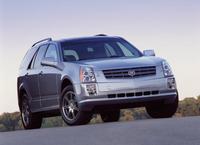New Car Review: 2004 Cadillac SRX-V8
THE AUTO PAGE By JOHN HEILIG
SPECIFICATIONS
MODEL: 2004 Cadillac SRX-V8
ENGINE: 4.6-liter V8
HORSEPOWER/TORQUE: 320 @ 6,400 rpm/315 lb-ft @ 4,400 rpm
TRANSMISSION: 5-speed automatic
WHEELBASE: 116 in.
LENGTH x WIDTH x HEIGHT: 195.0 x 72.6 x 69.5 in.
STICKER PRICE: $58,140
The Cadillac SRX is an all-new vehicle for Caddy, and it isn't built on a similar platform offered by another GM nameplate - yet. It belongs to a new class as well; it's a crossover, although Cadillac calls it a medium sport utility.
When I first heard about crossovers and saw a few examples, my first questions was, "Why don't they simply call them station wagons?" But the SRX, and the other crossovers we've had a chance to examine closely since they were first introduced, are unique vehicles. They truly are crossovers between station wagons and SUVs. The SRX is larger than a station wagon, yet smaller than the Cadillac Escalade, for example. It's a tad bigger than a mid-size SUV, which makes it somewhat confusing, but it still is a practical size.
Like the new lines of Cadillacs, the SRX is powered by a 4.6-liter Northstar V8 engine driving the rear wheels, or all the wheels if the all-wheel drive option is included (which it was in our tester). While the Northstar was developed for front-wheel drive vehicles, it has proven that it can handle rear-wheel drive vehicles as well and it's a great engine for this vehicle. This is only the second application of the Northstar for rear-wheel drive and the first for all-wheel drive, depending on which configuration you choose for your SRX.
The engine develops 320 horsepower and 315 lb-ft of torque, more than enough. A 3.6-liter Northstar V6 is also available, rated at 260 horsepower and 252 lb-ft of torque. My guess is that the V6 would probably be alright for the SRX, but if you're paying more than $50,000 for a vehicle, why not go for the bigger engine. The engine is attached to a smooth-shifting five-speed automatic transmission that was ideal because it required no thought. You just shift into "D" and go. There is a manual shift option that's really unnecessary.
We took the SRX on a long trip that included some Interstates, some two-lane winding roads, and a dirt road or two. We were in a convoy with a large diesel-powered Ford-based SUV because of the number of people who were traveling, but our Cadillac seemed more elegant.
The SRX cargo area is rated at 8.4 cubic feet with all three rows of seats in place; 32.4 cubic feet with the rear seats folded (the way we drove); and 69.5 cubic feet with the second and third rows folded. So itís not as large as the Escalade, but larger than many SUVs and almost all station wagons, at least these days.
Our vehicle was also popular with our grandson, who wanted to ride with us because he wouldn't have to share his father's car's DVD system with his younger sister. So he watched what he wanted to watch while she watched what she wanted to watch. The system in the Cadillac was nice because it provided wireless headphones for the DVD system. So he could watch his movie while we listed to the radio or CD up front.
Our SRX was also equipped with "magnetic ride control," a new GM suspension system. Essentially, the suspension permits a comfortable ride on all road surfaces, but when it senses that stiffness is required at any corner because of a tight turn or pothole, magnetic sensors react on metal filings in the liquid of the shock absorbers, limiting travel and stiffening the suspension. This explanation is simplistic, but I hope you get the idea. In any case, it works well. On the Interstates we drove as if it was any other Cadillac. On the winding road down to the river, though, the suspension stiffened up and the SRX handled like a sportier vehicle.
Our only complaint with the SRX was in entering, and it could have been a mental problem on my part. I thought it was a larger vehicle, so when I discovered the seating position was relatively low, I was surprised. I would have preferred a slightly taller ride position on my side, but it wasn't a problem.
The sticker on the SRX was $58,140, with a base price of $46,300. The major option was the "luxury performance" group ($7,145) which consisted of the magnetic ride control, all-wheel drive, a DVD navigation system with in-dash 6 CD changer, high intensity discharge headlamps, and an electrochromic inside rearview mirror. Other options were "ultraview", the world's biggest sunroof that we couldn't use because it was winter ($1,800); rear seat entertainment ($1,200); and a third row power seat ($1,000). The destination charge was $695.
All in all, the SRX was a fabulous vehicle that I regretted having to return. It's pricey, but it offers a lot , too.
© 2004 The Auto Page Syndicate



